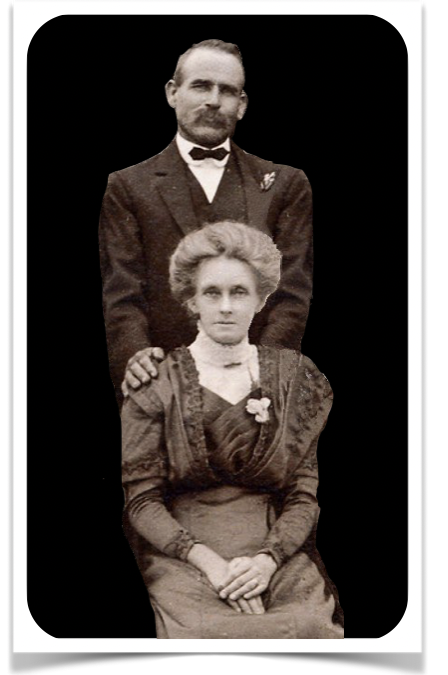
Rosewood History
Alexander RODGERS and Elizabeth LONEY
Name: Alexander RODGERS
Occupation: Farmer
Birth: 7th April 1861, Knocknamuckly, County Armagh, Northern Ireland
Immigration: 30th March 1873, the Light Brigade arrived Rockhampton from London 25th December 1872.
 Residence: “Torrens Vale”, Lanefield (Portion 84)
Residence: “Torrens Vale”, Lanefield (Portion 84)
Death: 18th February 1941, Rosewood, Queensland aged 79 years.
Burial: 19th February 1941, Ipswich General Cemetery
Religion: Church of England B (with Elizabeth and George)
Father: John RODGERS
Mother: Ellen WILSON
Marriage: 24th July 1888, at the residence of the bride, Calvert, Qld, by the Rev. James Milleventy.
Spouse: Elizabeth LONEY
Birth: 6th March 1868, Calvert, Queensland
Death: 22nd January 1958, Rosewood, Queensland aged 89 years.
Burial: 24th January 1958, Ipswich General Cemetery
Religion: Church of England B, Grave number B4564
Father: Absalom LONEY
Mother: Mary Ann McMURRAY
Children: 3
George Wilson RODGERS (1889-1958) = Mabel Lillian HILL
Edith Muriel /Maud RODGERS (1890-1967) = 1. William John JESSER 2. Richard AVISON
Ellen RODGERS (1891-1969) = Harold FRASER
Alexander Rodgers first stepped ashore at Rockhampton. The ship on which he immigrated to Queensland (Light Brigade), left London on Christmas Day 1872 carrying 400 immigrants. His father had died when he was three years old, so Alexander sailed with his mother Ellen (49) and siblings to Keppel Bay, Queensland, arriving shortly before his 12th birthday. Ellen, Alexander, Thomas (19), William John (16), Wilson (14) and Esther (8) came to join their sister Elizabeth Ann (Mrs Charles Lane) who had immigrated in 1870 on the Indus. Another sister Ellen Jane, and her husband Thomas Vaughan, were also on board the Light Brigade. When the steamer Queensland pulled up along side the Light Brigade, she was welcomed by several rounds of hearty cheers from those on board. Hats and handkerchiefs were waved furiously about in the air with the ladies showing more enthusiasm than the men. Every passenger had a health check and the Mayor, Mr. Edward Pike Livermore, who was on board, didn’t allow anyone to pass until he had placed a ‘tick” against his or her name. The immigrants then boarded the steamer.
“Good-bye!” “God bless you!” “Good luck!” were heard in scores, and not a few kisses were stolen by the tars in nooks and corners, and, if I mistake not, returned with interest by sundry pairs of lips, which trembled — and not a little — as the owners walked from the vessel to the steamer. They proposed that the best singers amongst the girls should assemble and “oblige the company,” and, nothing bashful, they at once consented, and until within a few miles of Rockhampton the game was kept alive, and many capital ditties warbled; some of the girls possessing excellent voices. As the steamer approached Rockhampton anxiety to be then near their future home, produced a general silence on the parts of both men and women, broken only now and then by inquiries as to “how many houses there were?” whether ” there was an hotel?” whether “there were any horses or carriages and whether Rockhampton was in the bush?” The first humpy that was seen caused a complete sensation and a merry laugh passed round; not a few of the more romantically inclined amongst the fair sex, declaring it was real “bea-u-ti-ful.” They were perhaps thinking of love in a cottage, and mutton roasted by a string. (1)
Alex and his brother Wilson found work with Mr. James Williamson, agent for the Great Western Carriers Company. Alex’s mother died 11 months after their arrival in Queensland, so when Alex had finished his contractual term of three years work, he went to live with his sister Elizabeth Lane at Lanefield. He received two more years of education at Calvert State School at the same time as his future bride was attending the school.
Alex went back to Rockhampton and resumed work at the same company as Wilson. The brothers worked as carriers in Central Queensland for Mr. Robert Kerr Bell (a carrier from 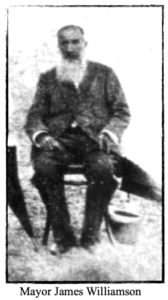 Emerald), who along with James Williamson, were now the directors of the Great Western Carriers Company. The company had three bullock teams and a large store. Williamson was General Manager and Agent in Rockhampton and Bell ran the buisness. Robert Bell put them in charge of his teams and they transported their loads right through to Malungra Station, down the Flinders River below Richmond Downs.
Emerald), who along with James Williamson, were now the directors of the Great Western Carriers Company. The company had three bullock teams and a large store. Williamson was General Manager and Agent in Rockhampton and Bell ran the buisness. Robert Bell put them in charge of his teams and they transported their loads right through to Malungra Station, down the Flinders River below Richmond Downs.
We know something of their trip from an article that was written for the occasion of Alex and Elizabeth Rodgers’ Golden Wedding Annversary in 1938.
After doing many long stages without water, they eventually arrived. They were only there about a week, when the Manager, Mr. Meredith, was killed from a fall off his horse. A few days later, one of their mates, Ted Borrum, was speared by the blacks and died. He was engaged in looking after 200 head of cattle that had just arrived there. They started on the return journey, facing long stages without even water to drink. They came across a plague of rats, and had to keep their beds up off the ground, or the rats would have run over them in thousands. At Cameron Downs they loaded wool; that being the first wool that came to the Central District. (2)
After 10½ months, the brothers arrived back at Emerald. They each bought a team from Mr. Bell, and began carrying on their own account. They aquired another team each, and with their four teams, they loaded timber for the Aramac and Winton Hospitals, returning with a load of wool.
At some stage Alex Rodgers left his teams with his brother and came back to Lanefield where he bought a farm of 204 acres from John O’Keefe (Portion 109). He left his brother-in-law Charles Lane to bailiff his property and went back to carrying with Wilson for a further 3½ years.
During these years James Williamson was elected Mayor of Rockhampton in 1884 and the Great Western Carriers Company was liquidated in 1885.
Alex sold his teams to Wilson and returned to Lanefield. He bought another 80 acre farm with a suitable house (Portion 84) from Thomas Charles Waller, a local builder. Alex was added to the electoral roll for Rosewood on 6th October 1887.
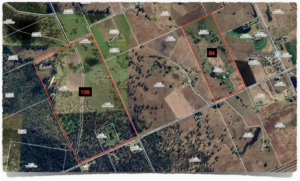
In July 1888, he married Elizabeth Loney, daughter of early pioneers of Calvert. Their bridesmaid was Elizabeth Rapson, step daughter of Samuel Waight. The Rodgers’ home was a five roomed pinewood house with a shingle roof. Alex had thirty acres under maize and the rest of his land was devoted to grazing. In addition to maize and potatoes, he had a dairy where he milked sixteen cows. Alex bought two more grazing farms in 1889, and settled down to farming and dairying.
Alex became a well-known breeder and exhibitor of stud Shorthorn cattle and Clydesdale horses. He rode a horse in the first Rosewood Show, and for many years was a staunch worker for the Show Society. He received his life membership badge from the A. & H. Association after being a financial member for 30 years. Additionally, he was always a successful exhibitor in the Southern district shows, including the Brisbane Exhibition.
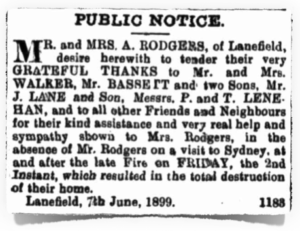
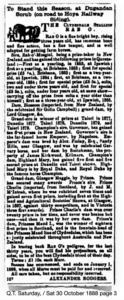 On Friday night, 2nd June 1899, their house was completely destroyed by fire. Elizabeth was home with her sister Mary Jane and the three children, but Alex was away in Sydney at the time. Just before midnight Elizabeth was woken up by a crackling noise and she found her bedroom was full of smoke. She immediately rallied the others and they all had to escape through a window because the flames were spreading so quickly. A few neighbours ran to assist and, because of their help, the detached kitchen was saved. The whole of the contents of the house, with the exception of a sewing-machine were consumed by the fire. It was thought that the fire started in the timber room at the back. The house and contents were insured with the Victoria Insurance Company for £300.
On Friday night, 2nd June 1899, their house was completely destroyed by fire. Elizabeth was home with her sister Mary Jane and the three children, but Alex was away in Sydney at the time. Just before midnight Elizabeth was woken up by a crackling noise and she found her bedroom was full of smoke. She immediately rallied the others and they all had to escape through a window because the flames were spreading so quickly. A few neighbours ran to assist and, because of their help, the detached kitchen was saved. The whole of the contents of the house, with the exception of a sewing-machine were consumed by the fire. It was thought that the fire started in the timber room at the back. The house and contents were insured with the Victoria Insurance Company for £300.
In February 1901 a man named Henry Wilkins died suddenly at the Rodgers’ farm. Henry (a native of Hamburg) came from Townsville where he had been employed at the railway workshops as an electrician. He and another man called Frederick Knape, a seaman, were living in a boarding house in Ipswich and both were working for Alex picking corn. Henry had a bad cough and said he had asthma. At some stage Knape asked Wilkins a question, and when he didn’t answer, he looked to where he was working and saw him lying on the ground with his head resting on his hands and he was frothing at the mouth. Knape went for a billy of water, and when he got back Wilkins was still in the same position and he couldn’t get him to get rally. He went and got Alex Rodgers. When they returned five minutes later, Henry Wilkins was dead. Alex reported the matter to John Lane, who was a Justice of the Peace, and to Acting Sergeant Perry. The inquiry held determined that he died as a result of apoplexy of the heart, enlarged liver, and some other complaints.
In 1907 Alex and Elizabeth built a new home in Rosewood (later mentioned as being next door to the Shire office). A handsome dwelling-house has just been completed to the order of Mr. Alex. Rodgers, of Lanefield. The house, which is situated in John-street, comprises a main building of 28ft by 24ft, divided into four rooms, with a hall 4ft 8in between the two front rooms, and a wing 26ft by10ft, which includes kitchen, servant’s room, and bathroom. The walls of the building are 11ft 6in high. The front verandah is 7ft in width, and the back one 9ft. Those are nicely finished off with palisading and lattice-work. The handsome entrance-door is of cedar with coloured side-lights; and the other doors, opening on to the verandahs are French lights, all of which have fan-lights over them. The building is lined and ceiled and nicely finished throughout. A great deal of forethought has been displayed in connection with it, which will make it a model of convenience. All surplus water will be carried by means of earthenware pipes to the water-table. The floor of the wash-house and the garden paths are cemented, and an ornamental fence will be erected in front. The residence, which is a handsome addition to the architecture of the main street has been leased to Mr. A. S. Ogg, our local bank manager. The work in connection therewith which has been splendidly executed reflects the greatest credit on our local contractor Mr. C. Ridsdale, who, I understand, has his hands full, for several months to come. (3)
Alex held a clearing-out sale in 1911. The advertisement below suggested he was giving up dairying and taking up horse-breeding.
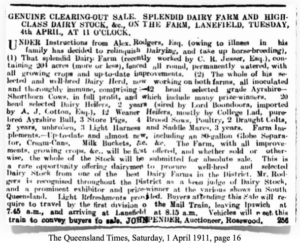
The tide must have turned for Alex for it seems that he didn’t relinquish dairy farming. He was a shareholder in the Queensland Farmers Co-operative Company at Booval, and sent cream there. He won the Pratt Cup for the most successful exhibitor at the Rosewood Show three times in succession, which meant he was able to keep it.
The Queensland Times of Thursday, 14 January 1915 ran a story. It’s wonderful to be able to read such descriptive words over one hundred years later.
Messrs. Alex. Rodgers and A. T. Waters have in their possession some first-class specimens of milking cattle. In looking over Mr. Rodgers’ property, no pains were spared to demonstrate to me the success which has attended his efforts. He has been on his present holding, which consists of 440 acres, for the past 26 years, and he has been amongst stock all his life. There are about 100 acres fit for cultivation, but there is a difficulty in finding suitable labour to work it, and only enough ground is utilised to produce sufficient feed for the dairy cattle during the winter months. There were 24 cows being milked at the time of my visit-purebred Shorthorn and grade Jerseys. The sire is a pure shorthorn.
At the last exhibition the well-known bull Profit was sold, and this animal, which was bred at Talgai, was the means of bringing Mr. Rodgers’s dairy stock into prominence. Following on the sale of Profit, a dark red bull, 16 months old, was bought for 40 guineas, at the last National Show, from Mr. Young, formerly manager of Talgai, the bull having won first prize at Warwick, Allora, and Brisbane from a large field of competitors All the shorthorn stock are Talgai blood, and Mr. Rodgers bought his present sire with the main desire to keep the colour of his as dark as possible, for, with the parents both roan, the progeny have a tendency to be white, a colour not desirable for dairymen. Beauty, a typical shorthorn cow, nine years old, had a wonderful show record, for in milking competitions alone she won not fewer than 19 first prizes (including the award at the Brisbane Exhibition), a record, I was informed, which no other cow in the Commonwealth can claim. Her record for 24 hours is 72lb of milk, and she yielded 38lb of milk on the morning which Sir Wm. MacGregor opened the last Gatton show. It will be remembered that he then spoke in eulogistic terms regarding the quality of this animal and stated that she was fit to be exhibited in any show-ring in the world. Beauty was bred by Mr. Chittick of Kangaroo Valley, New South Wales and is by Young Reuben. Pet is an animal which bids fair to command an enviable show-ring career, for amongst others she has won first prize for quantity and quality at Laidley, 1913, and first and reserve champion, at the last show.
At Lowood and Marburg, in 1914, Mr. Rodgers carried off the whole of the championships in the Shorthorn classes whilst, at Gatton, he scored champion and reserve championships for cows and championship for bull. At the last Ipswich Show Mr. Rodgers got no less than 30 ribbons for first. At the Rosewood Show he has won prizes for milking competition for four years in succession he has also scored first prize for best pen of dairy heifers for three years in succession at the Lockyer shows. The handsome silver cup donated by Mr. W. Pratt, of Ipswich, to the Rosewood Agricultural and Horticultural Association, for the most successful exhibitor, was won by Mr. Rodgers three times in succession, and has since become his property, been won at the shows of 1910-11-12. Mr. H. M. Stevens, M.L.A., also donated a beautiful silver cup for the winner of the milking competition and this has been won by Mr Rodgers’s exhibit twice in succession.
The milk yield from his dairy is separated, the cream being forwarded to Booval. The dairy shows that the owner of the property had his plans well thought out, for the building is very cool, but he has decided on building one closer to the milking shed, so as to lessen the labour of carrying the milk. The milking shed is really a skillion to a fine commodious hay shed, which is equipped with all the necessary appliances and conveniences required on a farm nowadays. The proprietor has commenced a number of improvements. In the matter of feeding his dairy animals from the hay shed, and when his scheme is completed he should hav. a very convenient plant. The floors of the milking-bails were laid out and cemented by Mr. Rodgers before any Dairy Act came in force, and they are kept scrupulously clean, The cow-yard has a foundation of logs, which have been covered with gravel, and this obviates a lot of inconvenience in wet weather. Close to the milking-shed and hay-shed is a large underground well, which supplies water for cleansing purposes and for stud stock. Calves are reared in preference to pigs. A Clydesdale stallion is kept for service on the farm, and Mr. Rodgers has some exceptionally choice mares which have won distinction at shows, beating some Maryvale mares. Poultry receives a good deal of attention and white Leghorn fowls provide the main supply of eggs. The whole property has a general air of prosperity, and Mr. Rodgers claims to have one the best paying dairy herds in the district. (4)
In 1916 Alex was president of the Rosewood Farmers’ Union, which aimed at improving conditions for men on the land.
In November 1918, Alex Rodgers was part of a deputation who met with the district engineer from the Railway Department, Toowoomba, Mr. Robert Miller. The deputation wanted a crossover and goodsheds at Lanefield Station, and the cream shed shifted closer to the platform and ramped to facilitate the loading of cream. The other men present were Jospeh Patrick Walsh, Harry Mumford, Daniel Crane, Arthur Waters, Charles Hopkins junior and George Kingston. Mr Miller said that the request appeared to him to be reasonable.
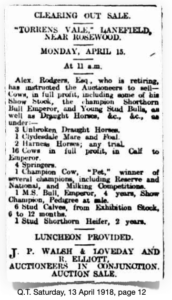 After living on their farm for 30 years, Alex and Elizabeth retired and moved into town and their son George took over the farm.
After living on their farm for 30 years, Alex and Elizabeth retired and moved into town and their son George took over the farm.
In early 1938 Alex had a serious illness, which led to one of his legs being amputated. He showed the stoic spirit needed to recover and he did so well that he was able to enjoy the occasion of his and Elizabeth’s Golden Wedding Anniversary in July 1938, marking their fifty years of marriage. The celebration was held in their home and included their family and a big gathering of friends. Elizabeth was dressed in a cigar brown frock trimmed with gold, and she wore a shoulder posy of jonquils.
A bouquet of Golden Ophelia and Dunlop Best roses, calendulas, croton leaves, and fern, tied with golden streamers, was presented to Mrs. Rodgers by Mrs. G. B. Reason, of Ipswich, and Mr. Rodgers received a golden rosebud. Crystal vases of Lady Hillingdon roses and Iceland poppies beautified the lounge, and in the dining room there was a rich display of calefidulas. The enclosure beneath the house was converted into a golden arbor with artistic over-head decorations of wattle, balloons, streamers, and ferns. There, with the fernery opening at the eastern side, an excellent supper was served. The chief table was beautified with bowls of Golden Ophella and Golden Dawn roses. In the centre of the table was a beautiful cake ornamented in gold and surmounted by a vase of gold shaded roses. The cake was the work of Mrs. Jesser. Iceland poppies, marigolds, and catanturos beautified the other three long tables. The place cards were marked with tinselled horseshoes, and a golden effect was achieved in the table decorations. (5)
Speeches were made by Henry Mark Alexander Grant, James Elder, Pat Lenehan, Demas Akes, Edward O’Donnell, George Dale and William Wass. George Kingston, Harold Fraser, Victor Jesser, Archibald Wilfred Johnston, William Ruhno, Dr. Robert Wallace, Edward O’Sullivan, George Loney and Marcus Jesser added words of appreciation of the guests of honour. Edward Bede Maher (later to become a Senator) congratulated the couple and said that their life should be an inspiration to the young people and he appreciated Alex’s help more than words could say. Cr. Arthur James Loveday (Chairman of the Rosewood Shire Council) responded on behalf of Alex Rodgers, who for health reasons, refrained from addressing the gathering. A vocal solo was given by Mrs. Emily Rose Imrie and community singing and dancing ensued. Among the gifts they received were a wireless set, a chiming clock, a fountain pen, and a crocodile skin bag.
High tributes of esteem were paid to Alex and Elizabeth Rodgers as excellent residents and pioneers of the district.
Alex’s favourite enjoyment was listening to the radio. He had been a subscriber to the “Queensland Times” since 1888 and enjoyed reading it until he died peacefully at home in 1941.
Edward Maher, M.L.A. (Leader of the State Opposition), said that he was deeply touched by the death of Mr. Alex Rodgers, whose friendship and work he had greatly valued. He said, “The late Mr. Rodgers was a pioneer in the truest sense, and in his youth had assisted the development of the far central and north-western areas of the State. The foundation of some of the best dairy herds around the district was attributable to this progressive stock breeder.”
Elizabeth inherited property described as resubdivision 13 of subdivision 2 of resubdivision 1 of subdivision 2 of Free Selection 7L, county of Churchill, parish of Walloon.
Elizabeth, Ellen and Edith Maud were bequeathed Resubdivisions 5, 6, 60, and 61 of subdivision 1 of portion 357b (to the depth of 70 feet from the surface only) and re subdivision 12 of subdivision 2 of portion 7, parish of Walloon; and portion 109, parish of Grandchester, both in the county of Churchill.
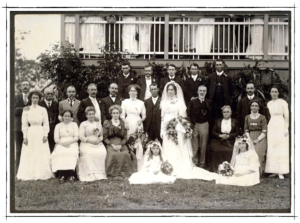
The photo above was taken at at Torrens Vale by Mr. H. Shelton of Ipswich, on the occasion of the marriage of William John Jesser and Edith Maud Rodgers (8th April 1912). The wedding ceremony was held at St Luke’s Anglican Church in Rosewood, after which the couple drove to the home of Edith’s parents for their elaborate wedding breakfast. Around 200 guests attended. The meal was served by Mr. Henry Duncan Dow of Rosewood and a three tier cake was made by Robert Sellars.
I’ve attempted to piece together the names of those pictured. Confirmation, however, would be welcomed.
George Wilson Rodgers is first on the left in the very back row, then George Loney, Frederick Absolom Loney, Yandina Frank aka “Dean” Jesser (best man) and groomsman Harold Fraser (who would marry Ellen Rodgers that coming September).
Ellen Rodgers (chief bridesmaid) is standing next to the groom. Next to Ellen are the bride’s parents – Alexander Rodgers with his hand resting on his wife Elizabeth’s shoulder. Next to Alex is Joseph Robert and Sarah Adelaide Loney (née Tippett). Their daughter, Vita Mary Florence Loney is seated next. There are two men behind her (possibly Wilson Rodgers and A. Rodgers from Blackbutt). The couple standing on the end is John Wilson Vaughan and wife Margaret Ann (née Loney).
The groom’s parents, Charles Thomas and Elizabeth Mary Jesser (née Spink) are on the right of the bride. Then another couple and a bridesmaid, Miss Jessie Grant.
The maids of honour sitting on the ground are Jessie Ellen Rodgers (Rockhampton) and Ivy Penilla Dolling (Rosewood).
© Jane Schy, 2024
Sources:
(1) Northern Argus (Rockhampton, Qld. : 1865 – 1874), Thursday 3 April 1873, page 2
(2) Queensland Times (Ipswich, Qld. : 1909 – 1954), Tuesday 26 July 1938, page 4
(3) Queensland Times (Ipswich Herald and General Advertiser Tuesday 23 July 1907, page 7
(4) Queensland Times (Ipswich, Qld. : 1909 – 1954), Thursday 14 January 1915, page 3
(5) Queensland Times (Ipswich, Qld. : 1909 – 1954), Tuesday 26 July 1938, page 4
Queensland, Australia, Immigration Indexes, 1848-1972
Queensland Registry Births, Deaths, Marriages
Australia, Electoral Rolls, 1903-1980
Ipswich Cemetery Records

2 Comments
Thanks a lot,Jane,for your extensive research on Alexander Rodgers and Elizabeth Loney.
My pleasure Kathryn.